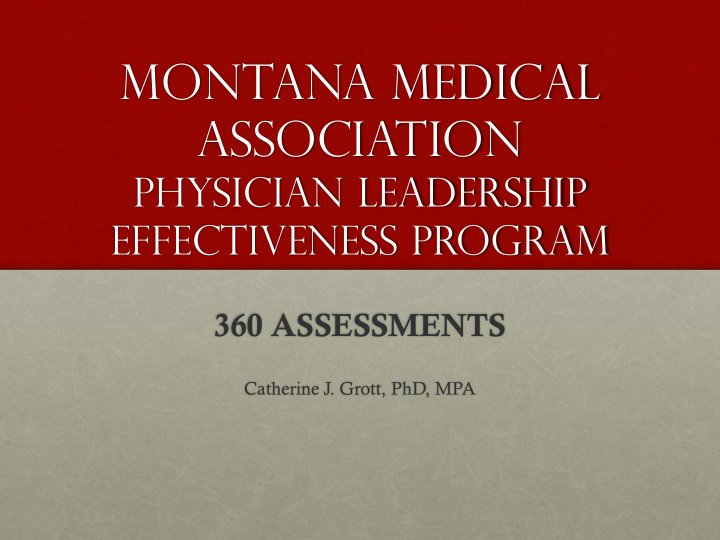



MONTANA MEDICAL ASSOCIATION Physician leadership Effectiveness program 360 ASSESSMENTS Catherine J. Grott, PhD, MPA
Development of survey tool • Several months to develop survey tool; tested to enhance validity. • Calculated like a score in a class but think of it more like a survey. • Survey tool includes perceptions by physicians and their colleagues regarding emotions, tasks, relationships, and engagement. • Open-ended questions were added to help enrich the data and gain a better understanding of leadership skills
360 Scores • A performance appraisal evaluation developed over 20 years ago that uses a multiple-input approach to performance feedback. • The assessments are a collection of data from colleagues, subordinates, supervisors and where appropriate, clients. • The goal of the 360 assessment is to illuminate how well employees are performing and how individuals might need to change their behaviors to create a more productive workplace. See: Edleson, H. 2012. Do 360 evaluations work? American Psychological Association, Vol. 43, No. 10, P. 58. US Office of Personnel Management, 360-Degree Assessment: An Overview, OPM-91-2958, retrieved from https://www.opm.gov/policy-data-oversight/performance-management/performance-management-cycle/rating/360assessment.pdf, September 1997.
Limitations • Not a random sample • A “snapshot” in time • Must get same 360 respondents to respond at follow-up or at least same number of people • Changes are made in fractions of a point • This is only one piece of data See: Jackson, E. 2012. The 7 reasons why 360 degree feedback programs fail, Forbes, retrieved from http://onforbes.es/Rnuo7q
Mosaic Emotional quotient ™ Average physician Average 360 confidence scores respondent scores 84% 87% Physicians and respondents both said physicians demonstrate strong moral principles, but are not sure how they are perceived by others.
Mosaic task quotient ™ Average physician Average 360 confidence scores respondent scores 75% 83% Physicians and respondents both believe physicians take ownership of issues, but don’t create written, long - term plans. Physicians also believe physicians think beyond their own self interest.
Mosaic relationship quotient ™ Average physician Average 360 confidence scores respondent scores 80% 85% Physicians and respondents believe physicians keep one’s word and are dependable, but physicians believe they might not demonstrate effective non-verbal skills and respondents believe they may not maintain relationships by managing tense situations
Mosaic Physician engagement score ™ Average physician Average 360 confidence scores respondent scores 88% 82%
Qualitative questions Open-ended questions are designed for rich feedback Comments gave good examples of strengths and areas of opportunity
How to use your assessment? • Identify your areas of strengths and reinforce them • Work with Wendy on areas of opportunity • Use this feedback experience to learn how to give constructive employee feedback • Seek out others in this class to learn from SEE: Stone, D., Patton, B., Heen, S. ( 2010). Difficult Conversations: How to Discuss what Matters Most, New York, NY: Penguin Books.
Physician Leadership PROGRAM QUESTIONS?
Recommend
More recommend